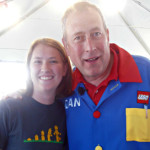- This topic has 7 replies, 5 voices, and was last updated 6 years, 7 months ago by
 Jim Rolfe.
Jim Rolfe.
-
AuthorPosts
-
September 23, 2018 at 11:53 pm #28751
 JoshKeymaster
JoshKeymaster@zaximillian I’m building a modular building using light yellow bricks. What colors go well with that??
September 24, 2018 at 1:42 pm #28753 Rich MillichParticipant
Rich MillichParticipantI’ll refer to BrickLink color codes and names so we both know which colors I’m talking about.
I am assuming some things. One is that you’re using color 103, Bright Light Yellow. The second is that this modular building is set in the modern day. The third is that Bright Light Yellow is your wall color. I wish I knew what the modular was depicting, as that would set my color palette in a different direction. There are a lot of arch bricks in Bright Light Yellow.
Usually, when I’m investigating more rare colors to use, I’ll open up BrickLink’s Color Guide and then select the Parts link for the colors involved, displaying the part selections in new tabs. In this way I can also save myself some money and grief if That One Part in That One Color is prohibitive. I had this problem when designing the Sovereign starfighter with Pearl Gold as a major color.
My first instinct was to pair Bright Light Yellow with a color that hits the sweet spot between too much contrast, too little. This means within the same color family. This means not only one to the left or right of Yellow on the color wheel, but adding in changes in saturation (how vivid the color is), or darkness of that color. This means that brown (which is actually dark orange) and greens are the first best bet.
Overall:
Tonal colors (white, gray, bleys and black):
White is close, but too close, so that’s out. Any of the grays or bleys would look dingy next to light yellow, so those are out (good for a dilapidated look though). Black is too much contrast. This eliminates the tonal category.Family colors (Yellow, Orange and Green):
Yellow drifts into tan as it darkens, so yellow and the tan colors are directly related too. Unfortunately, the tans are not a good fit here. Regular yellow and dark yellow strike out; there’s not enough contrast.
Color 4, Orange, is a decent fit, but would lend a ‘citrus’ look to it. A valid choice, but not the best.
Dark orange drifts into brown, so I treat orange and brown as the same color.
I like color 88, Reddish Brown, as your primary color and this are both nonstandard colors, and Reddish Brown evokes a woody Tudor look, if wood is what you’re looking for. Reddish Brown has a broad selection of parts, including the classic roof slopes and all the fencing you need for balconies.
Most of the Browns and darker Orange/Flesh colors are good, but it has to be the dark ones.
I like Reddish Brown the best. Keeping in mind that Reddish Brown is also a common paint color on metal, this might work for that too.
Same issue with the greens as with Orange: the brighter greens work, but there’s that ‘citrus’ look again. Avoid Olive entirely. Awful.Complementary colors (Red and Blue):
Aqua and Medium Blue look gooooood alongside this color. Azure is better than Medium Blue, but part selection comes into play for both of these colors. Regular Blue works too, but the darker the blue is, the more that the blue transforms the Bright Light Yellow into a secondary or accent color.
Among the reds, Dark Red is the winner, but this looks really cartoony and evokes fast food really.Purple is out entirely, as there is no shade of it, even a pastel one, that doesn’t clash too much.
Beyond the first two colors, a buffer color becomes difficult to work with, as Bright Light Yellow eliminates White and any of the grays/bleys from contention. Black would be my third choice, but my best advice there is to either use it sparingly, one plate thickness at a time, or in large blocks.
Color proportions matter in a large build, so (as @philmatt24 does), it’s smart to MOC up a little stack of which colors have more prominence, to keep the proportions steady, and which colors touch *and avoid touching* which. This way, at a glance, any builder can keep the colors consistent across the build for a more unified look. I build a little 2×2 column of these color swatches. Whether light touches dark for bold contrast, or the colors blend, having that little column in hand saves time and aggravation in the planning and acquisition stages. It also helps you see how the color blocking will react to light and gloss. I *highly* recommend this, especially when transparent colors touch solid colors.
For a modular, my first instinct is to avoid bright, bold colors and use more muted tones, as most houses and buildings are soothing instead of jarring or bold, and that weathering fades all colors somewhat and fairly quickly.
This brings the “sand” colors, pastels, earth tones, and the ‘tonal’ colors into play. I call white, grays, bleys and black tonal colors because they’re not on the color spectrum. I see this a lot in real buildings, so the pastel-earth-tonal palette makes a lot of sense.
However, that’s based on part selection too, so that’s a factor per color.
September 24, 2018 at 4:35 pm #28754 JoshKeymaster
JoshKeymasteryes, I misspoke, it is bright light yellow that I’m using.
It’s going to be a pretty plain building with a lot of the 1x5x6 glass as windows all around it. I brick built a parking lot in front of it. I’m not sure I want to give away the nature of the build yet, but it’s 2 story store, and won’t be very ornate. should be very strip mall looking. Think mattress store.
September 25, 2018 at 8:36 am #28759 Hannah DowParticipant
Hannah DowParticipantI love this, incidentally I’m a also about to parktake in a modular build using the bright light yellow. Excellent timing and I’m definitely taking your considerations into mind!
September 25, 2018 at 9:01 am #28760 Rich MillichParticipant
Rich MillichParticipantyes, I misspoke, it is bright light yellow that I’m using.
It’s going to be a pretty plain building with a lot of the 1x5x6 glass as windows all around it. I brick built a parking lot in front of it. I’m not sure I want to give away the nature of the build yet, but it’s 2 story store, and won’t be very ornate. should be very strip mall looking. Think mattress store.
With a lot of glass in place, the secondary part color will mainly from from the window frames. As such, this “secondary” color may become a main color since most of those windows are where the viewer’s eye will most likely go first.
September 26, 2018 at 12:28 pm #28773 Micah BeidemanParticipantSeptember 26, 2018 at 2:02 pm #28782
Micah BeidemanParticipantSeptember 26, 2018 at 2:02 pm #28782 JoshKeymasterSeptember 26, 2018 at 5:37 pm #28787
JoshKeymasterSeptember 26, 2018 at 5:37 pm #28787 Jim RolfeParticipant
Jim RolfeParticipantGreat info, thanks!!
-
AuthorPosts
- You must be logged in to reply to this topic.
